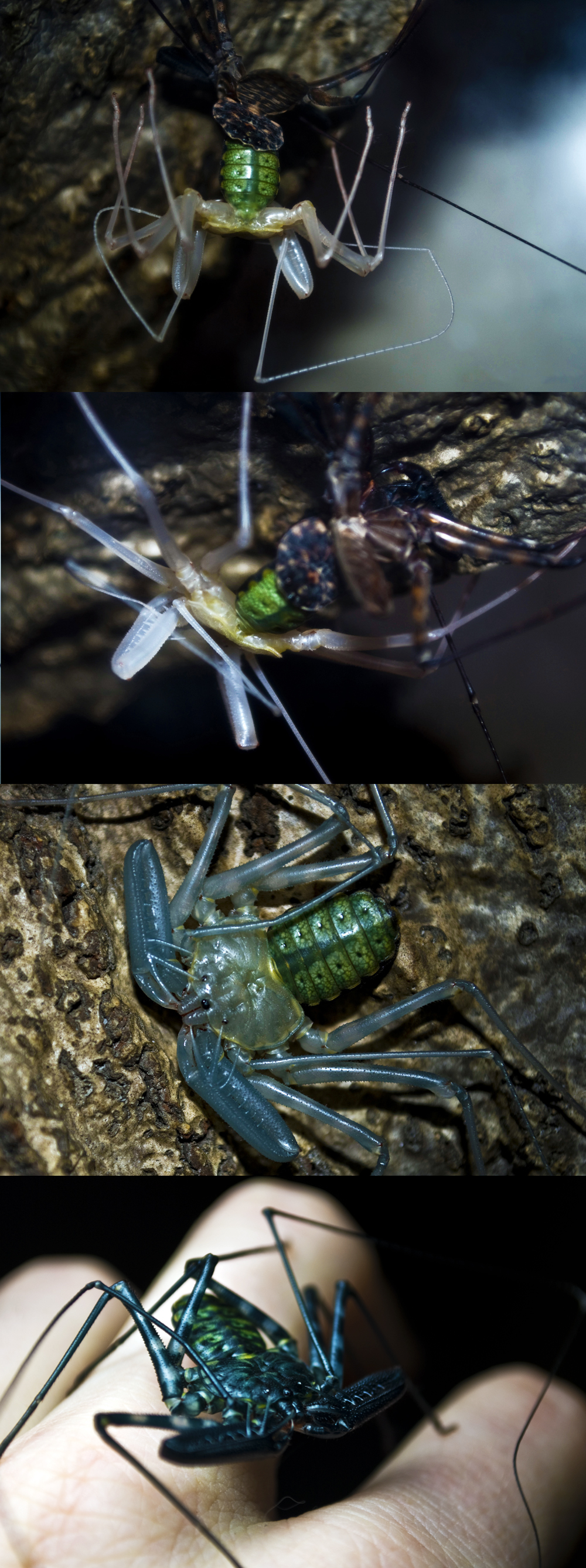|
Phrynichidae
Phrynichidae is a family of arachnid Arachnida () is a class of joint-legged invertebrate animals (arthropods), in the subphylum Chelicerata. Arachnida includes, among others, spiders, scorpions, ticks, mites, pseudoscorpions, harvestmen, camel spiders, whip spiders and vinegaroon ...s. Distribution The species of this family are found in Africa, South Asia and South America. Genera * Damoninae Simon, in Fage & Simon 1936 ** '' Damon'' C. L. Koch, 1850 ** '' Musicodamon'' Fage, 1939 ** '' Phrynichodamon'' Weygoldt, 1996 * Phrynichinae Simon, 1892 ** '' Euphrynichus'' Weygoldt, 1995 ** '' Phrynichus'' Karsch, 1879 ** '' Trichodamon'' Mello-Leitao, 1935 * indefinite subfamily ** '' Xerophrynus'' Weygoldt, 1996 References *Simon, 1892 : Arachnides. Etude sur les Arthropodes cavernicoles de île Luzon, Voyage de M. E. Simon aux îles Philippines (Mars et avril 1890), Annales de la Société Entomologique de France, vol. 61, p. 35–52. *Harvey, Mark S. 2003-01-01. Catalog ... [...More Info...] [...Related Items...] OR: [Wikipedia] [Google] [Baidu] |
Amblypygi
Amblypygi is an ancient order of arachnid chelicerate arthropods also known as African cave-dwelling spiders, whip spiders and tailless whip scorpions (not to be confused with whip scorpions or vinegaroons that belong to the related order Thelyphonida). The name "amblypygid" means "blunt tail", a reference to a lack of the flagellum that is otherwise seen in whip scorpions. Amblypygids possess no silk glands or venomous fangs. They rarely bite if threatened, but can grab fingers with their pedipalps, resulting in thorn-like puncture injuries. As of 2016, 5 families, 17 genera and around 155 species had been discovered and described. They are found in tropical and subtropical regions worldwide; they are mainly found in warm and humid environments and like to stay protected and hidden within leaf litter, caves, or underneath bark. Some species are subterranean; all are nocturnal. Fossilized amblypygids have been found dating back to the Carboniferous period, such as ''Weygoldtina''. ... [...More Info...] [...Related Items...] OR: [Wikipedia] [Google] [Baidu] |
Damon (genus)
''Damon'' is a genus of whip spiders, also known as tailless whip scorpions (Amblypygi) of the family Phrynichidae. Species * '' Damon annulatipes'' (Wood, 1869) * '' Damon brachialis'' Weygoldt, 1999 * '' Damon diadema'' (Simon, 1876) * '' Damon gracilis'' Weygoldt, 1998 * '' Damon johnstonii'' (Pocock, 1894) * '' Damon longispinatus'' Weygoldt, 1999 * ''Damon medius ''Damon medius'' is a species of arachnid of the family Phrynichidae. Description ''Damon medius'' can reach a body length of . This strictly arboreal and nocturnal whip spider has a flat body and fragile legs, by which it moves sideways like a ...'' (Herbst, 1797) * '' Damon sylviae'' Prendini, Weygoldt & Wheeler, 2005 * '' Damon tibialis'' (Simon, 1876) * '' Damon uncinatus'' Weygoldt, 1999 * '' Damon variegatus'' C. L. Koch, 1850 References BiolibPanarthropoda Amblypygi Arachnid genera {{Arachnid-stub ... [...More Info...] [...Related Items...] OR: [Wikipedia] [Google] [Baidu] |
Damon Diadema
''Damon diadema'' is a species of amblypygid, sometimes known as the tailless whip scorpion or Giant Amblypygid. It is found in Central Africa, Kenya, and Tanzania Tanzania (; ), officially the United Republic of Tanzania ( sw, Jamhuri ya Muungano wa Tanzania), is a country in East Africa within the African Great Lakes region. It borders Uganda to the north; Kenya to the northeast; Comoro Islands ... where it lives in caves, crevices and under fallen logs. The animal is long with a flat body. It is known as a tailless whipscorpion because of the long whip-legs that are the majority of its body width. Its legspan is about . References Amblypygi Arthropods of Africa Scorpions described in 1876 {{Arachnid-stub ... [...More Info...] [...Related Items...] OR: [Wikipedia] [Google] [Baidu] |
Arachnid
Arachnida () is a class of joint-legged invertebrate animals (arthropods), in the subphylum Chelicerata. Arachnida includes, among others, spiders, scorpions, ticks, mites, pseudoscorpions, harvestmen, camel spiders, whip spiders and vinegaroons. Almost all adult arachnids have eight legs, although the front pair of legs in some species has converted to a sensory function, while in other species, different appendages can grow large enough to take on the appearance of extra pairs of legs. The term is derived from the Greek word (''aráchnē'', 'spider'), from the myth of the hubristic human weaver Arachne, who was turned into a spider. Almost all extant arachnids are terrestrial, living mainly on land. However, some inhabit freshwater environments and, with the exception of the pelagic zone, marine environments as well. They comprise over 100,000 named species, of which 47,000 are species of spiders. Morphology Almost all adult arachnids have eight legs, unlike adult inse ... [...More Info...] [...Related Items...] OR: [Wikipedia] [Google] [Baidu] |
Phrynichus (genus)
Phrynichus (Greek: ) may refer to: People *Phrynichus (tragic poet) or Phrynichus Tragicus (6th-5th century BC), abbreviated in lexica as hryn.Trag. pioneer of Greek tragedy, most famous for ''The Fall of Miletus'' *Phrynichus (comic poet) or Phrynichus Comicus (late 5th century BC), abbreviated in lexica as hryn.Com. writer of old Attic comedy *Phrynichus (oligarch) (died 411 BC), Athenian general during the Peloponnesian War who took a leading part in establishing the oligarchy of the Four Hundred *Phrynichus Arabius Phrynichus Arabius (; grc-gre, Φρύνιχος Ἀράβιος, lit. 'Phrynichus “the Arab”') or Phrynichus of Bithynia ( grc-gre, Φρύνιχος ὁ Βιθυνός) was a grammarian of the Greek language who flourished in 2nd century Bith ... or Phrynichus Atticista (2nd century AD), abbreviated in lexica as hryn. grammarian and rhetorician Animals * ''Phrynichus'' (arachnid), a genus in the order Amblypygi {{disambig, hndis ... [...More Info...] [...Related Items...] OR: [Wikipedia] [Google] [Baidu] |


